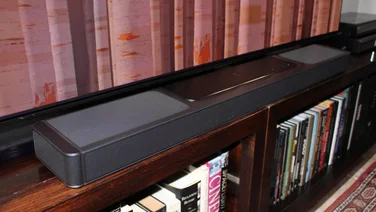To help us provide you with free impartial advice, we may earn a commission if you buy through links on our site. Learn more




The Yamaha RX-V371 is a budget AV amplifier that’s a little slimmer than usual. In spite of its reduced dimensions, it still has plenty of connectivity options that should simplify any home cinema setup.

The front panel is home to an oversized volume knob, four quick input select buttons, controls for the integrated radio and tone settings. We like the ability to save custom settings to each input, allowing you to upmix FM radio to 5.1 but playing Blu-ray movies without any processing, for example. There’s also a headphone out and auxiliary audio input, plus composite and stereo phono inputs hidden beneath a removable cover. The inclusion of a calibration microphone input is definitely welcome, as it will allow you to configure your speakers automatically for the best possible audio. It’ll probably only be used once, though, so we would have preferred if it was on the back rather than the front of the unit.
With no on-screen overlay function, this amp relies on its LCD display when changing settings. It’s fairly comprehensive, displaying the active input, volume level and any audio processing currently enabled, but with only a single-line display, it can take a while to familiarise yourself with the menu options. Thankfully you don’t need to do all this using the buttons on the front of the unit; the remote control has a sensible layout and is much more convenient for changing settings from the sofa.

The ubiquitous ports shot – click to enlarge
Connectivity can make or break any amplifier, and this is one area where the RX-V371 doesn’t disappoint. Around the back, four HDMI inputs should be enough to connect all your home-entertainment devices. Two component and three composite video inputs cover older devices too. There are HDMI, composite and component video outputs, but it can’t pipe analogue video inputs to the HDMI output, or HDMI inputs to the analogue outs.
Audio options are just as plentiful; two analogue, two optical and two coaxial digital inputs plus another analogue output make this a well-connected amplifier. However, it’s worth noting that while the front speaker outputs use binding posts, the surround and centre outputs use spring terminals. This will make it difficult to use thicker speaker cables, so you may need to settle for thinner ones.
We’ve experienced some questionable sound quality from Yamaha amplifiers in the past, so we were interested to see how well the RX-V371 would hold up under our testing. When watching movies, we noticed that high frequencies such as cymbals didn’t sound as crisp as they did on other amplifiers; even after a trip into the menus, we couldn’t match the vibrancy of similarly priced units from other manufacturers. It was only a slight difference, but it did dampen our enthusiasm for this amplifier.

Considering it costs less than £250, the RX-V371 has an impressive set of inputs and outputs, and its automatic calibration is an unexpected treat. However, the lack of an on-screen overlay can make advanced configuration a laborious task. Finding the right balance of frequencies and crossover points is important for a good home cinema setup, but doing so using the one-line LCD display is rather time consuming. The similarly priced Denon AVR-1312 has fewer inputs, but the on-screen menu system is much more helpful for beginners.






